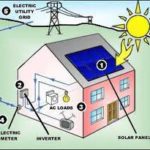 Increasing numbers of homeowners are installing photovoltaic (PV) arrays on their roofs in order to produce some or all of their own electricity. The costs of solar power have dropped sufficiently that complete paybacks of this investment are dropping to as low as five years and, on average, about 7-8 years. In another article, we examine whether PV is a good investment and found that, for many customers, it makes a lot of sense. If you have chosen to install PV on your roof, here are the most important things to consider if you are going to install PV (photovoltaics) or battery storage.
Increasing numbers of homeowners are installing photovoltaic (PV) arrays on their roofs in order to produce some or all of their own electricity. The costs of solar power have dropped sufficiently that complete paybacks of this investment are dropping to as low as five years and, on average, about 7-8 years. In another article, we examine whether PV is a good investment and found that, for many customers, it makes a lot of sense. If you have chosen to install PV on your roof, here are the most important things to consider if you are going to install PV (photovoltaics) or battery storage.
- Bidding: Get at least four bids from different contractors. Each one may recommend different panels, configurations and size of the installation. You should compare and contrast each of them.
- Timing: The sooner you make this investment, the better. The federal ITC (Investment Tax Credit) 30% tax credit ends in 2019. In 2020, it moves down to 26% next year. On a $20,000 installation, that amounts to about $800.
-
Warranty: Installing the solar panels yourself is a problem. Unfortunately, panel manufacturers will try to void any warranty claims made by someone whose panels were not installed by a manufacturer-approved installer. While solar panels rarely have defects, the larger concern for you should be the inverter, which is more unreliable and is frequently the subject of a warranty claim.
-
Battery Storage: If you reside in California, it may be worth considering a battery storage inclusion when you do your solar. Currently, the California incentive program (called SGIP) is offering very lucrative incentives that almost cover the cost of the batteries. We recommend you look into this at the time you do a solar installation, rather than down the road. Also, the 30% federal applies to the battery storage that is powered by solar. Given an estimated $7000-$8000 cost, these two incentives make storage system investments quite attractive.
- Inverter: Think about whether you want to get an expensive inverter or a lower-cost basic one. With the advent of “smart” inverters coming onto the market over the next five years, you may be better served by installing a lower-cost inverter today with an expectation of replacing it in the next 5-7 years (which is the average life of some of the lower-end inverters) with a smart inverter that will allow you to take advantage of some utility time-of-use or dynamic pricing rate plans. Currently, we recommend AGAINST micro-inverters, as they will make it difficult for you to utilize upcoming rate plans that may be advantageous to solar generators.
- Sizing: If there’s a chance that you will be investing in an electric car within the next ten years, you may want to install a system that will be a bit larger than your current needs. The use of PV-power to fuel your car improves the cost-effectiveness of your investment.
- Re-roofing: If you expect that you’ll need to replace your roof within the next 10 years, you may want to complete that re-roofing PRIOR to installing your PV system. Here’s the problem: if you need to replace your roof AFTER you’ve made the PV installation, you’ll be presented with a nasty surprise when you are informed that the PV system will need to be removed and reinstalled. This cost can be significant — as much as 50% of the price of the original installation. So if you have an older roof that will likely need to be replaced within 10-15 years, you may need to deal with that replacement before installing your PV system. Most PV contractors have contracts that place the responsibility for roofing-related costs upon you; this includes most leasing PV companies, such as Solar City. Yes, they own the PV array, but you are responsible for any roof-related costs in the event the panels need to be removed and reinstalled.
- Leasing: Is a low-cost means of reducing your monthly energy costs. We continue to believe that it is not a good “investment”, especially if you plan to live in your home for 7-10 years. Leasing should be viewed as a convenient and environmentally-responsible short-term way of reducing your monthly utility bills, but it will NOT appreciate the value of your property or provide the significant financial benefits offered by an owned solar installation.
- Conservation: Installing PV should not be seen as license to profligately use electricity because now it is “free” or “pre-paid”. At the same time as you do a PV installation, you should conduct an energy efficiency audit of your house to determine ways in which you can easily reduce consumption. This should be a mandatory step in determining the proper “size” of the installation. Sizing should be driven not just upon past consumption patterns but your forecast for future need. And conserved power is the CHEAPEST source of energy.
For more information about PV installation, we recommend the following links:


I like that you provided some tips on how to install solar-powered PV rays such as considering what type of inverter to use. It is recommended to use a lower-cost inverter in preparation for the development of a “smart” inverter in the next 5 years. This way, you get the same quality for less the price. If I were to install solar-powered PV arrays in my house, I would make sure to keep this in mind. Thanks.
I think that it is important to consider whether your home would do better with solar power. Many people don’t even recognize the benefits of solar powered homes. Do you have any other tips about choosing the right solar company for your house?
We have a fair amount of information on the website about buying solar. You can also check out this video that we shot in 2009 that offers a good overview.